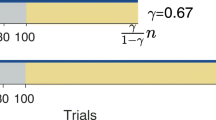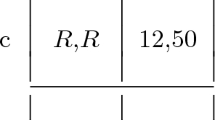Abstract
In many decision problems the decision-maker must ask a series of questions or select cues relevant to but prior to the decision. There are many strategies which would prescribe an order for asking such questions or selecting such cues. It is the purpose of the paper to describe a manner in which the strategy or strategies of the decision-maker can be analyzed. From this model can be derived limits corresponding to thepossible use of a particular strategy, and theeffective or observed use of the strategy or strategies by the decision-maker.
Similar content being viewed by others
References
Bradley, R. A. and Terry, M. E., Rank analysis of incomplete block designs. I. The method of paired comparisons.Biometrika, 1952,39, 324–345.
Cooper, B. E. The effect of ties on the moments of rank criteria.Biometrika, 1957,44, 526–527.
David, F. N. and Barton, D. E.Combinatorial chance. New York: Hafner, 1962.
Haden, H. G. A note on the distribution of the different orderings ofn objects.Proc. camb. phil. Soc., 1947,43, 1–9.
Hammond, K. R. and Castellan, N. J., Jr. Analyzing information-seeking strategies. Report No. 59, Behavior Research Laboratory, Inst. Behav. Sci., Univ. Colorado, 1965.
Hammond, K. R., Kelly, K., Castellan, N. J., Schneider, R., and Vancini, M. Clinical inference in nursing: V. The use of information-seeking strategies by nurses,Journal of Nursing Research, 1966,15, 330–336.
Kemeny, J. G. and Snell, J. L.Mathematical models and the social sciences. Boston: Ginn, 1962. Chap. II.
Kendall, M. G.Rank correlation methods. London: C. Griffin, 1955 (2nd ed.).
Luce, R. D.Individual choice behavior. New York: Wiley, 1959.
Mallows, C. L. Non-null ranking models.Biometrika, 1957,44, 114–130.
Moran, P. A. P. Partial and multiple rank correlation.Biometrika, 1951,37, 26–32.
Author information
Authors and Affiliations
Additional information
Preparation of this paper was supported in part by Fellowship 1-F1-MH-24, 324-01, from the National Institute of Mental Health. This paper comprises Publication Number 63 of the Institute of Behavioral Science, University of Colorado. The author would like to thank K. R. Hammond and D. W. Stilson for many helpful comments and suggestions.
Rights and permissions
About this article
Cite this article
Castellan, N.J. A model for the analysis of multiple strategies. Psychometrika 31, 475–490 (1966). https://doi.org/10.1007/BF02289518
Received:
Revised:
Issue Date:
DOI: https://doi.org/10.1007/BF02289518




